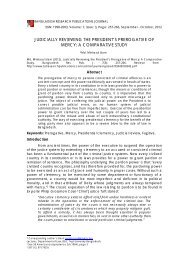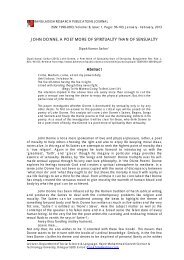Agricultural Growth <strong>and</strong> Agricultural Creditcostly f<strong>in</strong>anc<strong>in</strong>g option that is available only <strong>in</strong> <strong>the</strong> major cities, with a pre-requisite <strong>of</strong>f<strong>in</strong>ancial-collateral. In order to address <strong>the</strong> issue <strong>the</strong> GoB can make <strong>the</strong> f<strong>in</strong>anc<strong>in</strong>g choiceseasier <strong>in</strong> terms <strong>of</strong> <strong>in</strong>troduc<strong>in</strong>g favorable <strong>agricultural</strong>-<strong>credit</strong> guarantee <strong>and</strong> reduc<strong>in</strong>gadditional overhead <strong>in</strong>terest <strong>in</strong> cases <strong>of</strong> NGO-MFIs. The same was also suggested <strong>in</strong> case<strong>of</strong> a research held by Gloy et al. (2005).In addition to <strong>the</strong> above, any loop-holes discovered <strong>in</strong> <strong>the</strong> research, <strong>in</strong> <strong>the</strong> way <strong>of</strong> delivery<strong>of</strong> <strong>credit</strong> to <strong>the</strong> respective recipient <strong>of</strong> <strong>the</strong> same, will educate <strong>the</strong>m about alternativefeasible <strong>credit</strong>-options. In ano<strong>the</strong>r research by Mehmood et al., (2012) on Kasur District <strong>of</strong>Pakistan, showed that <strong>in</strong> some cases it can be common for many villagers, to take-uploan show<strong>in</strong>g that as an <strong>in</strong>vestment <strong>in</strong>to agriculture <strong>and</strong> agro-based activities, but <strong>in</strong>reality putt<strong>in</strong>g that <strong>in</strong>to social expenses like carry<strong>in</strong>g out marriage occasions, dowry,dissolv<strong>in</strong>g legal cases etc. Practices like this raise questions on to <strong>the</strong> issues <strong>of</strong> <strong>the</strong>effectiveness <strong>of</strong> <strong>the</strong> disbursed <strong>credit</strong>, if gett<strong>in</strong>g <strong>in</strong>to <strong>the</strong> paradigm <strong>of</strong> <strong>agricultural</strong>production, <strong>in</strong> <strong>the</strong> first place, let alone its role <strong>in</strong> <strong>in</strong>creas<strong>in</strong>g it.It has been noted <strong>in</strong> some previous research (Badiru, 2010; Rahman et al., 2011; CDF, 2006;Rahman, 2004; Gloy et al., 2005) that <strong>the</strong> cost <strong>of</strong> avail<strong>in</strong>g <strong>the</strong> <strong>credit</strong> also h<strong>in</strong>ders <strong>the</strong>farmers’ capacity to get <strong>the</strong> f<strong>in</strong>ance. As cited <strong>in</strong> a work<strong>in</strong>g paper by Nagarjan <strong>and</strong> Meyer(2005), <strong>the</strong> different costs that add up to <strong>the</strong> available f<strong>in</strong>ance schemes, range fromservice charge for high volume <strong>of</strong> multiple transactions <strong>of</strong> lesser amounts <strong>of</strong> <strong>the</strong> users, to<strong>the</strong> cost for provid<strong>in</strong>g <strong>the</strong>m with <strong>in</strong>formation about <strong>the</strong>ir sav<strong>in</strong>gs or <strong>credit</strong> accounts severaltimes, <strong>in</strong> contrast to any urban account holder. This is due to <strong>the</strong> fact that, <strong>in</strong> contrast to<strong>the</strong> account-holders <strong>of</strong> metropolitan areas, <strong>the</strong> rural account holders live more scattered<strong>and</strong> based on <strong>the</strong>ir earn<strong>in</strong>g, both <strong>the</strong>ir sav<strong>in</strong>gs <strong>and</strong> requirement for f<strong>in</strong>ance is alsocomparatively low (Nagarjan <strong>and</strong> Meyer, 2005). Thus a proper balance <strong>of</strong> cost between<strong>the</strong> lender <strong>and</strong> borrower <strong>of</strong> f<strong>in</strong>ance must be established (Mehmood et al., 2012).O<strong>the</strong>rwise, <strong>the</strong> agri-<strong>credit</strong> payout may not aga<strong>in</strong>, be an <strong>in</strong>put <strong>in</strong> <strong>in</strong>creas<strong>in</strong>g <strong>the</strong> <strong>agricultural</strong>production.In many o<strong>the</strong>r preced<strong>in</strong>g researches, pro<strong>of</strong> <strong>of</strong> a positive association between <strong>agricultural</strong><strong>credit</strong><strong>and</strong> higher productivity has been established. Numerous former studies havestressed on <strong>the</strong> improvement <strong>of</strong> <strong>the</strong> f<strong>in</strong>ancial segment, as ensur<strong>in</strong>g a better accessible<strong>and</strong> approachable rural fund-source can positively re<strong>in</strong>force productivity (Lev<strong>in</strong>e et al.,2000, McMillan <strong>and</strong> Woodruff, 2002; Cull <strong>and</strong> Xu, 2005). Butler <strong>and</strong> Cornaggia (2009) alsohave explored positive connection between countries with easier fund access <strong>and</strong> raisedproductivity. If people have easier access to gett<strong>in</strong>g funds, more <strong>of</strong> that money can beput <strong>in</strong>to sett<strong>in</strong>g up a bus<strong>in</strong>ess, develop<strong>in</strong>g new skills <strong>and</strong> expertise, explor<strong>in</strong>g product<strong>in</strong>novation, assur<strong>in</strong>g proper allocation <strong>of</strong> resources, all <strong>of</strong> which can lead to expansion<strong>and</strong> <strong>growth</strong>. In o<strong>the</strong>r words, <strong>the</strong> size <strong>of</strong> <strong>the</strong> exist<strong>in</strong>g bus<strong>in</strong>ess can be enlarged with <strong>the</strong>support <strong>of</strong> trouble-free money access (Beck et al, 2005).S<strong>in</strong>ce <strong>the</strong> liberation <strong>of</strong> Bangladesh <strong>in</strong> 1971, <strong>the</strong> economy first <strong>and</strong> foremost depended on<strong>the</strong> <strong>agricultural</strong> sector. Agriculture rema<strong>in</strong>s very important, as it is <strong>the</strong> prerequisite to ensurefood security <strong>and</strong> is <strong>the</strong> major source <strong>of</strong> employment <strong>and</strong> livelihood, to <strong>the</strong> greatestnumber <strong>of</strong> people <strong>in</strong> Bangladesh, as well as its contribution through forward <strong>and</strong>backward l<strong>in</strong>kage with <strong>the</strong> rest <strong>of</strong> <strong>the</strong> economy (Asaduzzaman, 2009). Without do<strong>in</strong>gproper utilization <strong>of</strong> this sector, <strong>the</strong> overall economic improvement will not emerge.Keep<strong>in</strong>g <strong>in</strong> l<strong>in</strong>e, with <strong>the</strong> importance <strong>of</strong> this sector, <strong>the</strong> Bangladesh Government hasallocated a considerable portion <strong>of</strong> <strong>agricultural</strong> <strong>credit</strong> <strong>and</strong> also encourages o<strong>the</strong>rorganizations (NGO-MFIs, PCBs, FCBs etc.) to extend <strong>the</strong>ir lend<strong>in</strong>g facilities to this field.Apart, from reduc<strong>in</strong>g customer duty on commodities <strong>in</strong> <strong>the</strong> budget <strong>of</strong> f<strong>in</strong>ancial year 2010-11, an allocation <strong>of</strong> Tk. 4,000 corer has been proposed as subsidy to <strong>the</strong> <strong>agricultural</strong> sector(State <strong>of</strong> <strong>the</strong> Bangladesh Economy <strong>in</strong> FY2010-11: First read<strong>in</strong>g). With <strong>the</strong> reference <strong>of</strong> thispaper, State <strong>of</strong> <strong>the</strong> Bangladesh Economy <strong>in</strong> FY2010-11, which is prepared under <strong>the</strong>program called Independent Review <strong>of</strong> Bangladesh’s Development (IRBD) state thatBangladesh is currently negotiat<strong>in</strong>g with IMF for a <strong>credit</strong> deal amount US$ 1(one) Billion forthree years (2011-14) under its Extended Credit Facility (ECF) arrangement. Accord<strong>in</strong>g to<strong>the</strong> center for Policy Dialogue (CPD) Bangladesh, a clearance for loan package isexpected to get from IMF Board <strong>in</strong> February next year. This would be <strong>the</strong> first time <strong>in</strong> threeyears that Bangladesh is opt<strong>in</strong>g for an IMF program. In FY2009-10, <strong>the</strong> GoB allocated Tk.5,965 corer for agriculture sector, <strong>of</strong> which Tk. 5,076 cores were assigned for <strong>the</strong> non-177http://www.bdresearchpublications.com/journal/
Sharmeen <strong>and</strong> Chowdhurydevelopment sector which is 85% <strong>of</strong> <strong>the</strong> total budget <strong>the</strong> M<strong>in</strong>istry (Titumir et al., 2010).Similarly, 69% was allocated for non-development sector for <strong>the</strong> M<strong>in</strong>istry <strong>of</strong> Forest <strong>and</strong> 56%for <strong>the</strong> M<strong>in</strong>istry Fisheries <strong>and</strong> Livestock (Titumir et al., 2010). Accord<strong>in</strong>g to allocation for <strong>the</strong>non-development sector is Tk. 5,684 cores, it is 84.35% for Agriculture M<strong>in</strong>istry <strong>and</strong> 56% forM<strong>in</strong>istry <strong>of</strong> Fishery <strong>and</strong> Animal Resources.More specifically, about 111,168.80 million Taka was distributed to <strong>the</strong> farmers as<strong>agricultural</strong> loan <strong>in</strong> 2009/10(Bangladesh Economic Review 2010; 2011). In addition, GoBtakes <strong>the</strong> effort to provide necessary <strong>in</strong>put supports (such as seed, irrigation, fertilizer etc to<strong>the</strong> farmers. For <strong>in</strong>stance, <strong>in</strong> 2009/10, about 49,220 million Taka was released as subsidy onfertilizer <strong>and</strong> for o<strong>the</strong>r <strong>agricultural</strong> <strong>in</strong>puts (Bangladesh Economic Review 2010; 2011). Forirrigation expansion, <strong>the</strong> allocation <strong>of</strong> budget was Tk. 427 crore <strong>in</strong> this FY2010-11 (Titumir etal., 2010).All <strong>the</strong>se effort is taken to escalate <strong>the</strong> <strong>agricultural</strong> <strong>growth</strong>, because this disbursement <strong>of</strong><strong>agricultural</strong> <strong>credit</strong> is a key factor <strong>in</strong> <strong>the</strong> development <strong>of</strong> <strong>the</strong> <strong>agricultural</strong> sector, whichachieved a <strong>growth</strong> rate near 4% <strong>in</strong> FY2008-09 <strong>and</strong> 4.39% <strong>growth</strong> rate has been projectedby Medium Term Monitory Framework (MTMF) <strong>of</strong> <strong>the</strong> government, <strong>in</strong> FY2009-10 while, GDPis grow<strong>in</strong>g at a constant pace <strong>of</strong> close to 6% <strong>in</strong> all <strong>the</strong>se fiscal years (Titumir et al., 2010).Now, <strong>the</strong> question is whe<strong>the</strong>r this <strong>credit</strong> facility actually drives <strong>the</strong> <strong>agricultural</strong> <strong>growth</strong> ornot. If this <strong>credit</strong> really did not contribute <strong>in</strong>to <strong>the</strong> <strong>agricultural</strong> <strong>growth</strong>, <strong>the</strong>n is it wise toallocate such a big portion from budget for a develop<strong>in</strong>g country like Bangladesh?One <strong>of</strong> <strong>the</strong> major factors that need to be assured is if <strong>the</strong> huge amount <strong>of</strong> agri-<strong>credit</strong> thatis be<strong>in</strong>g arranged to be paid-out to <strong>the</strong> growers, are put <strong>in</strong>to <strong>the</strong> model <strong>of</strong> <strong>agricultural</strong>production or <strong>agricultural</strong> activities, <strong>in</strong> <strong>the</strong> first place. Or, are <strong>the</strong>y just discharged fromvarious formal/non-formal lend<strong>in</strong>g <strong>in</strong>stitutes <strong>and</strong> used/misused <strong>in</strong> o<strong>the</strong>r activities, o<strong>the</strong>rthan agriculture. As, if this cannot be certa<strong>in</strong>ed, <strong>the</strong> greater amount <strong>of</strong> lend<strong>in</strong>g that GoB,arranges for <strong>the</strong> <strong>growth</strong> <strong>of</strong> <strong>the</strong> crop-sector cannot be atta<strong>in</strong>ed. Also, hold<strong>in</strong>g equalimportance is <strong>the</strong> issue <strong>of</strong> mak<strong>in</strong>g <strong>the</strong> funds easily accessible, as well as, <strong>the</strong> terms <strong>of</strong> <strong>the</strong><strong>credit</strong>, underst<strong>and</strong>able. This <strong>in</strong> return, will encourage our growers to take f<strong>in</strong>ancial aid fromvarious lenders <strong>and</strong> use it for <strong>the</strong>ir production activity.There were not so many researches done on <strong>the</strong> relation <strong>of</strong> <strong>credit</strong> <strong>and</strong> productivity, strictlyon <strong>the</strong> perspective <strong>of</strong> Bangladesh. However, namely researches like that <strong>of</strong> Rahman et al,(2011) have shown evidence <strong>of</strong> a highly optimistic co-relation (0.938; with statisticalsignificance at 1% level) between available agri-<strong>credit</strong> <strong>and</strong> greater production. The studyhad also come up with highly positive results based on data collected <strong>and</strong> carry<strong>in</strong>g outstatistical tests. It was revealed, that farmers who have access to agri-<strong>credit</strong>, have 1.21times higher production <strong>of</strong> crops, <strong>in</strong> contrast, to <strong>the</strong> farmers <strong>and</strong> growers who don’t have<strong>credit</strong> support for <strong>the</strong>ir cultivation <strong>of</strong> crops. Specifically, food gra<strong>in</strong> production, fisheriesproduction have higher correlation (0.948); whereas, livestock products like milk, meat<strong>and</strong> eggs have been found to have moderate correlation (0.772, 0.938 <strong>and</strong> 0.688respectively) all statistically significant at 1% level.Based on <strong>the</strong> secondary statistical research work, on <strong>the</strong> <strong>context</strong> <strong>of</strong> Bangladesh, that hasbeen conducted so far, it can thus be said that, <strong>the</strong>re is a positive correlation betweenraised <strong>credit</strong> accessibility <strong>in</strong> agriculture <strong>and</strong> higher production yield. Options like mak<strong>in</strong>g<strong>the</strong> farmers/growers buy/rent farm<strong>in</strong>g mach<strong>in</strong>eries, help <strong>the</strong>m get seeds, fertilizers,cultivation-equipment etc. aide <strong>the</strong>m <strong>in</strong> work<strong>in</strong>g towards a very optimistic yield <strong>of</strong> crops.ConclusionIn recapitulation, it can be mentioned that agriculture is <strong>the</strong> only viably-substantiallivelihood earner <strong>in</strong> rural Bangladesh. It not only provides <strong>the</strong> poorer with economicfreedom,but it also has <strong>the</strong> capacity to alleviate poverty. The <strong>agricultural</strong> growers arefaced with a range <strong>of</strong> <strong>credit</strong>-options to get <strong>the</strong>mselves <strong>in</strong>to <strong>the</strong> efficiency-cycle,<strong>in</strong>clud<strong>in</strong>g, short-term, long-term f<strong>in</strong>anc<strong>in</strong>g <strong>in</strong>struments; as well as, with various sources <strong>of</strong>f<strong>in</strong>ance like formal, <strong>in</strong>formal <strong>and</strong> quasi-formal. The availability <strong>of</strong> various purpose-based<strong>and</strong> program-based loan options has <strong>in</strong> one way made life more simple, as fund whichwas earlier unth<strong>in</strong>kable, is now approachable for <strong>the</strong> agro-growers; on <strong>the</strong> o<strong>the</strong>r h<strong>and</strong>,multiplied impediment arises out <strong>of</strong> complex loan-term <strong>in</strong>terest calculation, which is attimes, far beyond <strong>the</strong> comprehension <strong>of</strong> <strong>the</strong> mostly illiterate rural population. Onus is upon<strong>the</strong> farmer to weigh down <strong>the</strong> cost <strong>and</strong> benefit <strong>of</strong> fund<strong>in</strong>g methods that are availablehttp://www.bdresearchpublications.com/journal/178
















